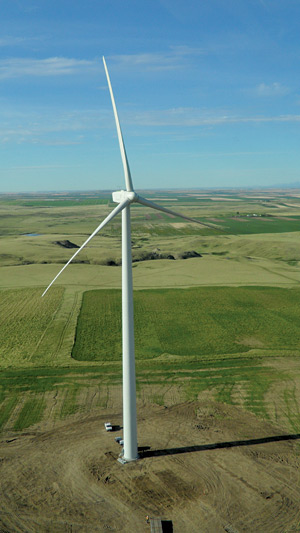The landscape of the northern plains near Cut Bank came alive recently as the single largest wind farm in Montana officially began spinning its turbines. Hundreds of onlookers, including one of the project’s biggest advocates, Gov. Brian Schweitzer, witnessed the Sept. 14 unveiling of the latest advancement in wind energy in the state, the Rim Rock Wind Farm, which plans to feature 126 towers planted across 21,000 acres in Glacier and Toole counties.
Located between Shelby and Cut Bank, the $400 million commercial operation has the energy capacity of 189 megawatts — enough to power roughly 60,000 homes. A majority of the site’s turbines — 78 — are completed and the facility is expected to be fully operational by the end of the year. The site has another 120 megawatts of available capacity if future growth were to occur.
Rim Rock is the fifth industrial-sized wind farm operating in Montana, and the third owned by NaturEner, a renewable energy company based in Madrid, Spain, that develops hydro, wind and solar energy projects in North America and Europe.
The Glacier Wind Farm, roughly 25 miles south of the Rim Rock site and also owned by NaturEner, is the largest overall wind energy operation in the state, encompassing two separate sites that total 140 turbines producing 210 megawatts a year.
Once considered audacious, the Glacier and Rim Rock projects represent the enterprising efforts to establish wind energy as a viable industry across Montana’s windswept flatlands. In the last decade wind-generated energy has proliferated across the world, reaching 239 gigawatts or 3 percent of the global electricity demand. Through last year the U.S. was second only to China in wind power generation. Wind farms could supply 20 percent of the nation’s energy grid by 2030, meeting targets set last year by the U.S. Department of Energy.
Since becoming governor in 2005, Schweitzer has fixated on expanding Montana’s energy portfolio, whether it’s tapping into coal and oil opportunities or utilizing renewable resources like wind.
“I’m a big energy guy,” he told the Beacon. “It’s also a personal journey of mine.”
Growing up on a farm in the windy Judith Basin, he said he recognized the sheer value of wind. Old windmills provided electricity for homesteaders 100 years ago, and these modern wind farms, like Rim Rock, fuel the state’s economy and help stave off foreign fuel dependency, he said.
Today almost 600 megawatts of wind-generated energy is produced in Montana compared to less than 1 megawatt in 2003.
“It was an uphill battle,” Schweitzer said, adding, “Now people recognize we have some of the best wind energy in the world.”
A Harvard University study released in late 2009 listed Montana as the state with the second-greatest potential for wind power, tied with Kansas and behind only Texas.
Tapping into that potential has proved difficult. For example, the Rim Rock Wind Farm experienced financial pitfalls almost immediately, due in large part to the economic recession. When financing stalled, Schweitzer arranged a meeting in late 2011 with Morgan Stanley, a global financial services firm. Morgan Stanley agreed to provide $320 million in loans for construction while NaturEner agreed to scale back Rim Rock from its original goal of developing 206 turbines that would produce 309 megawatts.
 |
|
Rim Rock Wind Farm. photo courtesy of Natureener usa |
Another challenge, which is ongoing, involves the completion of the Montana-Alberta Tie-Line (MATL). If and when it’s completed, the 214-mile power transmission line would connect a new substation near Lethbridge, Alberta, with NorthWestern Energy’s Great Falls substation, creating a major avenue for energy distribution. Lawsuits from Canadian landowners are currently holding up the final small stretch of the MATL.
Those lawsuits are being reviewed and if they are resolved the line could be completed in the first quarter of 2013, according to Greg Copeland, the development director for NaturEner USA.
Environmental concerns also surfaced and led to changes late in development. NaturEner agreed to move 25 towers a half-mile away from the Kevin Rim, which the Bureau of Land Management has identified as a key nesting area for raptors. Montana Audubon, a statewide bird conservation group, raised opposition over raptors being threatened by the turbines.
After the tower relocations, Montana Audubon signed a memorandum of understanding with NaturEner agreeing that both groups would continue working together to mitigate possible effects on birds and bats.
“(The Rim Rock project) has a unique kind of structure and as such it took a little but more in the way of innovating solutions to get over all those challenges,” Copeland said. “There were a number of unique challenges. Each one could have scuttled the entire project, but each one of them was able to be overcome.”
For more information on the Rim Rock Wind Farm, visit www.naturener.net.